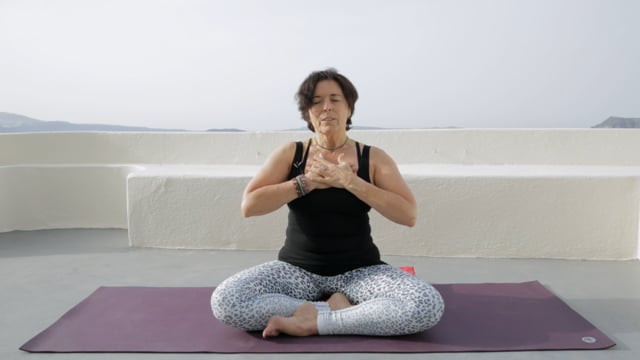All Levels › Vidya Heisel
-
 27:16
27:16Kundalini Yoga to Open the Heart
Starting with meditation and pranayama, this class is a fabulous sequence of Kundalini Kriya, featuring breath work and Kundalini yoga sequence to open the heart and free any negative or blocked energy or emotions.
-
 36:52
36:52Yoga Nidra for Relaxation
Yoga Nidra is a 'yogic sleep', but the aim is not to fall asleep! This is a rewarding relaxation practice which will help melt tension in your body and mind by rotating your consciousness and awareness. You may want a bolster under your knees, a blanket under your head and an eye pillow, or you can simply lay in savasansa. Find what is most comfortable for you.
-
 10:25
10:25Handstand Tutorial for Beginners
This yoga tutorial works on the different stages and how to approach a handstand, and is great if you've never tried handstand before. Work on long holds in downward facing dog and plank to build strength, then work on progressing to handstand with this class! You will need your mat by a wall.
-
 08:13
08:13Shoulder Stand Tutorial
A shoulder stand tutorial which works through the preparations to build up to this inversion. If you're not quite ready for a shoulder stand, use this class to find suitable alternatives and learn how to grow your strength and confidence. You may want to place your mat by and will need a blanket.
-
 14:48
14:48The Eighth Limb: Samadhi
In this yoga philosophy class, we explore the concept of Samadhi. Samadhi is the eighth and final limb of Patanjali's eight limbs of yoga, and it means enlightenment. This can be quite a challenging concept for us to grasp, but it is often thought of as freedom from the limited sense of self.
-
 16:17
16:17The Seventh Limb: Dhyana
The seventh limb of yoga is Dhyana, or meditation. The eight limbs of yoga represent the path of meditation, which is considered to be the greatest tool in our yoga practice to help us experience Samadhi by understanding and mastering the mind to experience equanimity and balance.
-
 08:50
08:50The Sixth Limb: Dharana
Patanjali's sixth limb of yoga is Dharana, which means concentration. This limb is all about refining your ability to focus and concentrate, so your mind doesn't wander and resist the practice.
-
 10:33
10:33The Fifth Limb: Pratyahara
The fifth limb of yoga is Pratyahara which means withdrawal of the senses or turning inwards. This refers to the first step of meditation after laying the groundwork with the practices in the previous limbs. Withdraw from external stimulus by turning off your phone or retreating to a quiet room for a time and take your attention inwards.
-
 14:48
14:48The Fourth Limb: Pranayama
The fourth limb of Patanjali's path is Pranayama which means life force energy. It is thought that the more of this life force energy we can cultivate, the more healthy, awake, alive and aware we will be, and the greater our longevity. Learn about some of the different types of breath work used to practice pranayama.
-
 17:53
17:53The Third Limb: Asana
Patanjali's third limb of yoga is Asana, or the physical practice of yoga. Despite there being very little mention of yoga postures in the Sutras, asana traditional refers to the practicing of sitting for meditation, which then evolved to encompass the yoga poses we know today.
-
 14:16
14:16The Fifth Niyama: Isvara Pranidhana
The fifth and final Niyama is Isvara Pranidhana, or surrender to the absolute. This Niyama is all about how we respond to occurances beyond our control; are we a victim living in fear or can we see and embrace the beauty in the unknown?
-
 15:42
15:42The Third Niyama: Tapas
The third Niyama is Tapas, which means self-discipline. It also translates as 'burning' which can be looked at in a few different ways, including a burning passion for leading a spiritual yogic life.
Join the Wellbeing Revolution
This is your yoga, your way.
Build a happier, healthier, more sustainable life.
